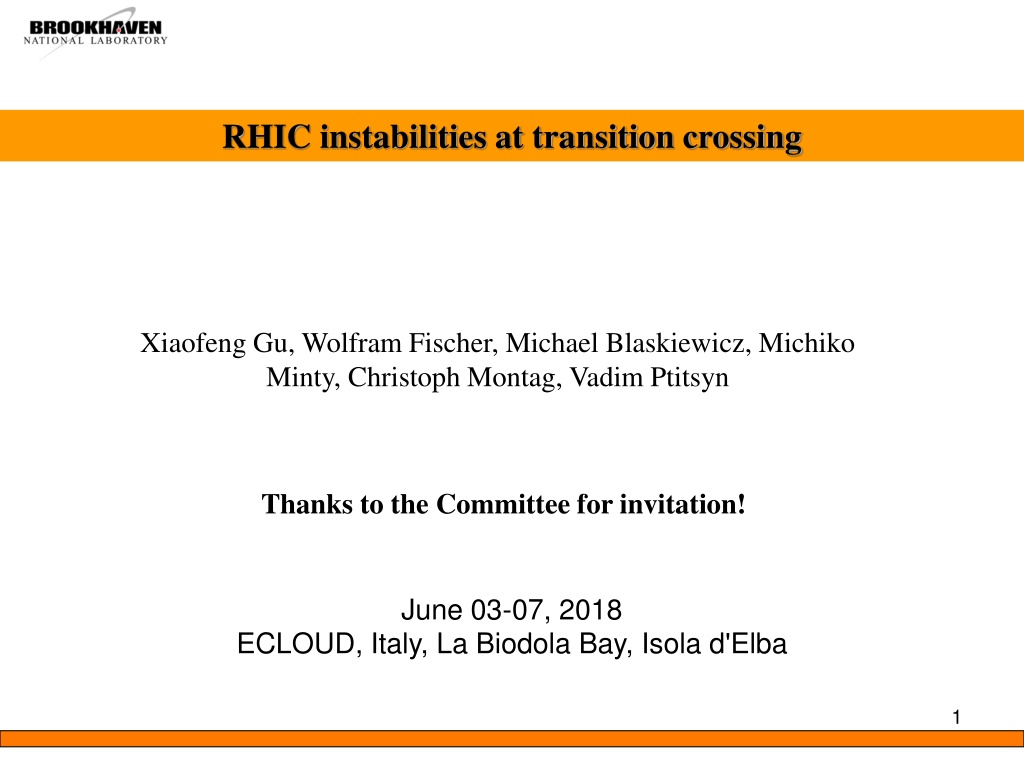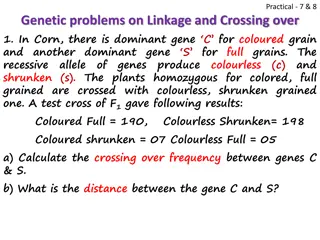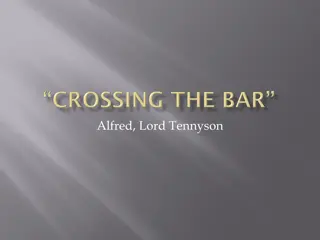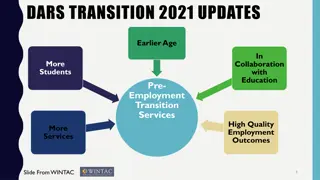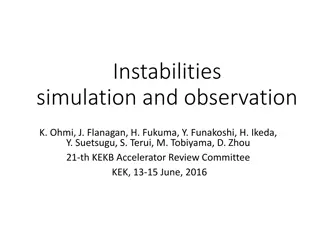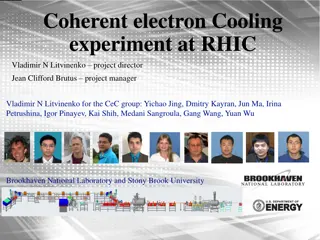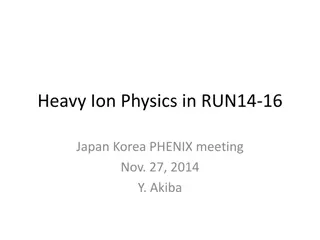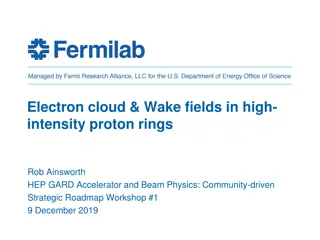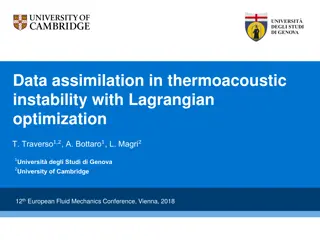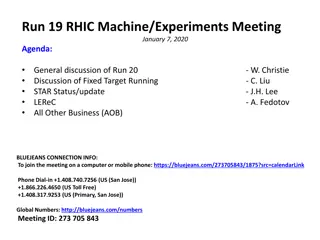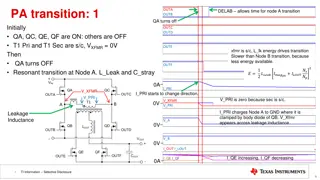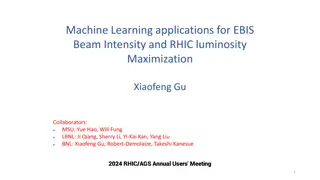RHIC instabilities at transition crossing
In this study, the instabilities observed during transition crossing at RHIC are examined, focusing on the effects of single and multi-particle dynamics along with electron clouds. The time scales characterizing the transition crossing process and the instrumentation utilized for monitoring and analysis are also discussed.
Download Presentation

Please find below an Image/Link to download the presentation.
The content on the website is provided AS IS for your information and personal use only. It may not be sold, licensed, or shared on other websites without obtaining consent from the author.If you encounter any issues during the download, it is possible that the publisher has removed the file from their server.
You are allowed to download the files provided on this website for personal or commercial use, subject to the condition that they are used lawfully. All files are the property of their respective owners.
The content on the website is provided AS IS for your information and personal use only. It may not be sold, licensed, or shared on other websites without obtaining consent from the author.
E N D
Presentation Transcript
RHIC instabilities at transition crossing Xiaofeng Gu, Wolfram Fischer, Michael Blaskiewicz, Michiko Minty, Christoph Montag, Vadim Ptitsyn Thanks to the Committee for invitation! June 03-07, 2018 ECLOUD, Italy, La Biodola Bay, Isola d'Elba 1
Outline Introduction Observation Methods Summary 2
RHIC a High Luminosity (Polarized) Hadron Collider E-lens LEReC/CeC PoP 2:00 o clock 10:00 o clock RHIC PHENIX 8:00 o clock 56 MHz 4:00 o clock STAR 6:00 o clock LINAC EBIS Booster AGS Operated modes (beam energies): U U 100 GeV/n Au Au 3.8/4.6/5.8/10/14/32/65/100 GeV/n d Au 9.8/19.5/31.2/100 GeV/n Cu Cu 11/31/100 GeV/n p p 11/31/100/205/250 GeV He-3 Au 100 GeV/n p Al 100 GeV/n p Au 100 GeV/n Ru Ru 100 GeV/n Zr Zr 100 GeV/n Achieved peak luminosities: Au Au (100 GeV/n) p p (250 GeV) Performance defined by 1. Luminosity L 2. Proton polarization P 3. Versatility (species, E) 155 1026 cm-2 s -1 245 1030 cm-2 s -1
Instability during Transition In RHIC, all ions above 23 GeV except proton have to cross transition energy, with slow superconducting magnet ramping rate Single particle effects -> chromatic non-linearity -> different momentum particle to cross transition at different times Multi-particle effects -> bunch shape mismatch to RF bucket (induced by low frequency self fields) and microwave instability (higher frequency self fields) These multi-particle effects will increase the momentum spread, enhancing the chromatic nonlinear effect and leading to particle loss Electron clouds -> bunches are short at transition triggering e-cloud formation -> e-clouds lower the stability threshold given by the machine impedance and enhanced by electron clouds In RHIC, instability has limited total bunch intensities in the past (not presently)
Time scales Characterize transition crossing Two time scales to characterize transition crossing 1/3 The non-adiabatic time: not described 3 2 ??? co?( ?) ?? ??? ?0 ??= ? 4??2 by adiabatic Hamiltonian (longitudinal) The non-linear time: single particle non- 2) ???? ?? ???= (?1+ 1.5 ?? ? linearity chromatic effect (transverse) S.Y. Lee, Accelerator Physics, p302
Instrumentation for Transition Crossing Instabilities in RHIC 1. Beam Decay and BBB beam loss 2. IPM for Emittance 3. Coherence signal 4. Electron cloud detector 5. Longitudinal Bunch length & Shape 6. Vacuum 7. 10Hz & TBT BPM 8. Longitudinal phase tomographic reconstruction
Button BPM for coherence measurement 2 components for slow instability 3 components for fast instability Signal used in MCR M. Blaskiewicz et al, PAC 2003
Electron Cloud Detector Grid 1 Grid 2 Collector EC signal used in MCR U. Iriso and W. Fischer, PRST-AB 8, 113201 (2005). U. Iriso-Arizo, et al, 2003, PAC
Outline Introduction Observation Methods Summary 9
BBB Beam Loss During Transition (Fill18176, 4/6/2014) BBB Intensity Blue and Yellow Ring The Blue instability, horizontal plane, 0.1 sec after transition. BBB Beam Loss with Gap (Fill9628, 01/23/2008) V. Ptitsyn, et al, HB 2008 WGA04,
Total Beam Loss (Fill18176, 4/6/2014) Transition Crossing Beam Decay: 4500%/hour Bunched Intensity:13% BBB Beam Loss
Coherence Signal (Fill18176, 4/6/2014) Transition Crossing Yellow ring Coherence Signal (V) Blue Coherence Signal (H&V)
Electron Cloud Signal (Fill18176, 4/6/2014) Bunch Length Transition Crossing Re-bucketing E-cloud Signal E-cloud Yellow (V) Blue (H&V)
Vacuum (Fill19704, 3/17/2016) Bunch Length Transition Crossing Vacuum
10Hz BPM and Mean Orbit (Fill19704, 3/17/2016) Xmean Yellow ring Blue ring bpm during transition Blue ring Yellow ring Minty Michiko 2016-03-17elog
WCM and Landau Damping (Fill 19807) Blue Landau Damper Beam Load before Transition 2.4 1011 Bunch Area 2.2 1011 Bunch height Bunch Width
Outline Introduction Observation Methods Summary 17
Used Methods in RHIC for Transition Crossing Control 1. gt-jump implemented 1.In-situ baking 2.NEG 2. Octupoles control 3.Scrubbing 3. Chromaticity control 4.Solenoid, anti-grazing rings . 4. Lower Accelerator RF voltage 5. Landau Cavity for shape Oscillations after Transition 6. Split transition lattice 7. Feedback of quadrupole oscillations
GammaT Jump and Transition Crossing GammaT Jump Chrom Jump OctupoleCurrent Betafunction
Chromaticity --- Sextuple (Fill19765~19766, 4/13/2016) Yellow Emittance (V) Fill19765: Before Vertical Chrom Change Fill19766: After Vertical Chrom Change Yellow Beam Decay After Vertical Chrom Change
Octupole for tune spread (2002, Fill9450~9650,2008 and 19751-19754, 2016) Octupole = -15 Octupole = -18 Yellow Emittance (V) Octupole Intensity -18 Emittance(avg) W. Fischer, -15 Intensity C. Montag, J. Kewisch, D. Trbojevic and F. Schmidt, PRST-AB 084401 (2002)
Accelerator Cavity Voltage (Fill 19679) J. Wei, PAC2005, p4087 6.5% beam loss Transition Phase jump Voltage
E-cloud: NEG coating in RHIC NEG coating started from 2005, increased the total stored charge in operation p+ Au79+ Cu29+ d+ Au79+ Au79+p+ Au79+ Notes: charge also limited by effects other than total charge (injectors, transition), dynamic pressure can be limited by single location (experiment).
Ecloud: scrubbing with Au and Proton 2011 pp operation: Scrubbing used in 2007 Au-Au operation: Vacuum Intensity 7 high intensity fills in about 2 h, Reduced dynamic pressure in worst location by more than 1 order of magnitude
Au Bunch Intensity Evolution 2(t) L(t)=1 t-jump, octupoles at transition Nb e(t)b*(t)h(b*,ss,q) f0N 4p scrubbing with protons EBIS, Booster 4 2 1, AGS 8 4 2 merge AGS 12 6 2 merge ultimate goal (25% more) main limits: - transition instability in RHIC (e-clouds) - Machine protection 111 bunches 43 bunches Wolfram Fischer IPAC16-WEZA01 H. Huang, K. Gardner, K. Zeno, RF, et al. 25 25
Outline Introduction Observation Methods Summary 26
Summary - all ions excepts protons cross transition in RHIC, a relatively slow ramping sc machine - observed transition instabilities with rise time as fast ~15 ms in the past - clearly driven by electron clouds - presently not limiting operations after implementation of a number of mitigation measures - Used methods include gamma-t jump, octuples, fast chromaticity change, RF voltage, tune and orbit control, NEG coating of warm pipes, scrubbing over several years
More Methods for Transition Crossing Control 1. Reactive loading for less impedance 2. Rf system feedback 3. Avoiding phase jump by continuously varying phase and voltage 4. Artificial blow up longitudinal emittance 5. Using flattened rf (9MHz and 28MHz) 6. Temporarily changing the orbit circumference using programmed V and phase 7. Rf manipulation to eliminate bunch length oscillation. 8. Reduce rf voltage 9. Simulation? Handbook of Accelerator Physics and Engineering, 2nd print. J. Wei, p286
References 1. 2. 3. 4. Intensity Dependent Effects in RHIC, Jie Wei, BNL-66781 Transition Crossing in the RHIC, Jie Wei, BNL 45923 A First order Matched Transition Jump at RHIC, S. Peggs et al, PAC1993 p168 Overcoming a fast transverse instability by means of octupole-induced tune spread in the Relativistic Heavy Ion Collider C. Montag, J. Kewisch, D. Trbojevic and F. Schmidt, PRST-AB 084401 (2002) Electron cloud measurements and simulations for the Brookhaven Relativistic Heavy Ion Collider, W. Fischer, et al, PRST AB 2002 Transverse Instabilities in RHIC, M. Blaskiewicz et al, PAC 2003 RHIC Electron Detector Signal Processing Design, J. Gullotta, et al, PAC03 Electron Cloud and Pressure Rise Simulations for RHIC, U. Iriso, et al, PAC03 Electron Detectors for Vacuum Pressure Rise Diagnostics at RHIC, U. Iriso, et al, PAC03 Calibration of RHIC Electron Detectors, P. He, et al, PAC03 Transition Pressure Rise in RHIC Run-4, W. Fischer, et al, C-A/AP-#184 Commissioning of a first-order transition jump in RHIC, J. Kewisch and C. Montag, PAC2003, p1694 Design of a fast Chromaticity Jump in RHIC, C. Montag et al, PAC2003 Commissioning of a first-order matched transition jump at the Brookhaven Relativistic Heavy Ion Collider, C. Montag and J. Kewisch, PRST AB 2004 Electron Cloud Phase Transition, U. Iriso, et al, 2004, C-A/AP/#147 Electron Cloud Observations at RHIC in Run-3, U. Iriso, et al, Jan. 29, 2004 Analysis of Electron Cloud at RHIC, U. Iriso, et al, EPAC04 Preliminary Estimation of the Electron Cloud in RHIC, L. Wang, et al, EPAC04 Maps for Fast Electron Cloud Simulations at RHIC, U. Iriso, et al, EPAC04 Observation of electron-ion effects at RHIC transition, J. Wei et al, PAC2005, p4087 Estimates for secondary electron emission and desorption yields in grazing collisions of gold ions with beam pipes in the BNL Relativistic Heavy Ion Collider: Proposed mitigation, P. Thieberger et al, PRST-AB 7, 119901 (2005) Electron induced molecular desorption from electron clouds at the Relativistic Heavy Ion Collider, U. Iriso and W. Fischer, PRST-AB 8, 113201 (2005) Electron Induced Molecular Desorption of the RHIC Beam Pipes, U. Iriso, et al, AP note #191 Benchmarking Electron Cloud Data with Computer Simulation Codes, U. Iriso, et al, EPAC06 Electron-Impact Desorption of the RHIC Beam Pipes, U. Iriso, et al, EPAC06 Electron Clouds in the Relativistic Heavy Ion Collider, U. Iriso , Thesis 2006 Electron Cloud Observations and Cures in RHIC, W. Fischer, et al, PAC07 A Diagnostic for Improving Transmission Through Transition in RHIC, P. Cameron, 2007 Analysis of intensity instability threshold at transition at RHIC, W. Fischer, et al. BNL-79903-2008-CP Electron Cloud Observations and Cures in RHIC, W. Fischer, et al, PRST-AB 041002 (2008) Crossing Transition at RHIC, V. Ptitsyn et al, HB2008 FEEDBACK DAMPER SYSTEM FOR QUADRUPOLE OSCILLATIONS AFTER TRANSITION AT RHIC, N. P. Abreu et al, EPAC02, p3242 Simulation of Electron Cloud Density Distributions in RHIC Dipoles at Injection and Transition and Estimates for Scrubbing Times, P. He, et al, PAC09 Measurements of fast transition instability in RHIC, V. Pitisyn et al. BNL-90793-2010-CP, IPAC10 p1638 Experience with split transition lattices at RHIC, C. Montag et al, IPAC10 Longitudinal Dynamics simulation at Transition crossing in RHIC with new Landau Cavity, C. Liu et al, HB2014 More . 5. 6. 7. 8. 9. 10. 11. 12. 13. 14. 15. 16. 17. 18. 19. 20. 21. 22. 23. 24. 25. 26. 27. 28. 29. 30. 31. 32. 33. 34. 35. 36. 37. 38. Review of single bunch instabilities driven by an electron cloud, F. Zimmermann PRST-AB 124801 (2004)
